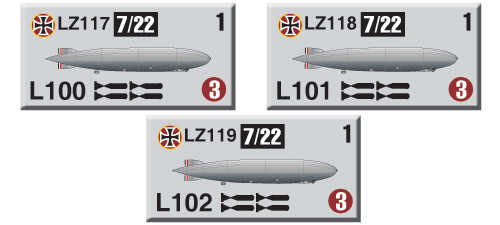| GWAS:
Airships Preview
Part I: The Battle Scenarios
October 2013
When Ernie Wheeler sent in a very well
researched Daily Content submission that included new variant
rules for airships in Great
War at Sea plus four new airship-centric operational
scenarios, it looked like a good start for a ten-scenario supplement for GWAS much like
our North
Wind and Alaska’s
War supplements for Panzer
Grenadier. And
so we have Great
War at Sea: Airships with five airship-centric battle scenarios and five operational
scenarios. Previews of the five battle scenarios follow:

Battle Scenario 1
DODECANESE
Summer, 1912
With the Turkish fleet unwilling to sortie, Italy faced no
opposition in the Eastern Mediterranean and soon began grabbing
Turkish island possessions in the Aegean Sea. This did not
sit well with the Austro-Hungarian Empire, which saw it as
a dangerous precedent that could inspire land grabs by Greece
and Serbia. Though Austria was allied to Italy, the Austrian
navy had a long-term rivalry with its Italian counterpart
and would not have balked at an order to rein them in. Furthermore,
had Austria’s airship program produced better results,
Austria’s navy would have had the scouting capability
to spot an eastbound Italian invasion fleet and vector-in
the battlefleet to deter or, if necessary, destroy Italian
expansionist moves. But if the Regia Marina had gotten wind
of such Austrian countermoves, they would have brought in
their own airships to escort the invasion fleet and warn of
any approaching trouble.
Note: This scenario uses pieces from Mediterranean
and Zeppelins.
Comments: This is an interdiction mission
with the Austrian battle fleet engaging the Italian occupation
force and trying to destroy enough troop transports to keep
them from taking the Dodecanese Islands. Each side gets two
airships, which have only minimal offensive capability themselves,
but both also have eight pre-dreadnought battleships and plenty
of armored cruisers, so the player who uses his airships to
best effect for gunnery spotting will likely come out on top.
Battle Scenario 2
BLAZE OF GLORY
November 1st, 1918
Designed to draw-out the Royal Navy for a final battle, the
last gasp of the Imperial High Seas Fleet was to have been
a suicide raid on the Thames Estuary. Had the German sailors
obeyed orders, the first ships to reach the Thames would have
been the Imperial battlecruiser squadron. Had zeppelins escorted
them, they could have created an even bigger conflagration.
Note: This scenario uses pieces from Jutland
and Zeppelins.
Comments: This is one of those elaborate
battle scenarios, which I really enjoy designing. The tactical
map approximates a section of the Thames estuary, with the
central shaded hexes representing an island and the southwestern
and northwestern board edges being land. There are shore batteries
on the island and land edges, but the British player starts
out with only three airships on the board. The German player
gets five battlecruisers and seven late-model airships, though
he has to roll for each one to see if it was destroyed on
the way into the estuary by mines or local air patrols. The
German battlecruisers and zeppelins must attack the shore
batteries, trying to knock them out and escape before the
British battlecruisers (which enter the board piecemeal during
play) corner them and wipe them out.

Battle Scenario 3
SKY DREADNOUGHTS
Fall, 1923
At the end of World War I, the Treaty of Versailles required
Germany to cease zeppelin production and hand-over her existing
zeppelins to the victorious Allies. Having none of it, many
zeppelin crews destroyed their airships before the Allies
could get hold of them, but zeppelin L72 survived
and went to France to be rechristened Dixmude. Just
a few years later, France was invading German territory over
missed war reparations payments, and if the Weimar Republic
had taken a more militant stance against French aggression,
she might have looked at the last great zeppelin designs of
World War I as weapons to help her tiny navy get past French
blockades.
Note: This scenario uses pieces from US
Navy Plan Gold and Zeppelins.
Comments: In this scenario, a French blockading
force led by two battlecruisers plus Airship Dixmude,
is setup in the center of the tactical map while the Weimar
German surface raiders enter from the northwest edge and must
try to run the French blockade and exit the southeast edge.
The Germans score the full VP value of each Weimar ship that
exits the southeast edge, while the French score the full
VP value of each Weimar ship that fails to exit the southeast
edge for any reason (being sunk or otherwise). The French
outgun the Germans, but the Germans get assistance from zeppelins
L100, L101 and L102, which enter from the
southeast edge. The zeppelins have plenty of bombs to attack
the French ships directly and can also spot for gunnery to
help weaken and slow French ships to help the blockade-runners
slip by. But Dixmude has a few bombs of her own,
so she’ll be able to chase-down ships that make it through
and bomb them, unless one of the German Sky Dreadnoughts shoots
her down.

Battle Scenario 4
FEEDING FRENZY
Summer, 1924
American airship designs favored performance and maneuverability
over armament. But while the airships could not attack enemy
ships directly, their high-altitude capability made them an
unparalleled system for spotting enemy shipping, guiding American
warships to the target, and providing gunnery spotting with
little danger from enemy anti-aircraft fire. This could give
American merchant raiders a fair chance, even against a powerfully
escorted convoy.
Note: This scenario uses pieces from Sea
of Troubles and Zeppelins.
Comments: This scenario puts airships as
gunnery spotting systems to the test with four American armored
cruisers raiding a large British convoy protected by a battleship
and destroyers. To win, the American player must score 20
more victory points than the British player, so the fast but
vulnerable cruisers must coordinate with the airships. They
must dart in and out to do maximum hits to transports spotted
from the air before the British battleship can destroy them.
Battle Scenario 5
A LATE SPRINT
Spring, 1918
By early 1918, tens of thousands of doughboys were unloading
at French ports every week. This boded ill for German war
prospects and the few long-range surface raiders, as the Imperial
High Seas Fleet would be hard pressed to take-on an American
troop convoy with a strong escort. But if those raiders were
to rendezvous at sea with a squadron of the newest long-range
zeppelins, together they would make a force that just might
have a chance against the Americans.
Note: This scenario uses pieces from Jutland,
Sea
of Troubles and Zeppelins.
Comments: Here, the zeppelins take center
stage as offensive weapons systems. Along with a state-of-the-art
German battlecruiser and two light cruisers, six late-model,
long-range zeppelins with substantial bomb capacities attack
American troop transports. As escorts for thirty large transports,
the Americans have two older battleships plus eight destroyers,
giving the Germans a target-rich environment. The Germans
have to act aggressively, because the Americans are running
for port and get one victory point for each transport that
exits the northeast board edge. The zeppelins will need to
chase-down the transports that make it closest to port and
bomb them; During this, the surface raiders pick-off stragglers
while trying to avoid damage from the American battleships.
That does it for the battle scenarios. Tune in next time
for a preview of the five operational scenarios in GWAS:
Airships!
Click
here to order GWAS: Airships in its print edition and get in on the action!
Click here to order Airships as a download, and take to the skies even faster!
|


